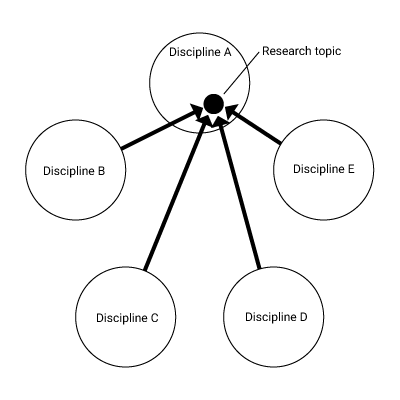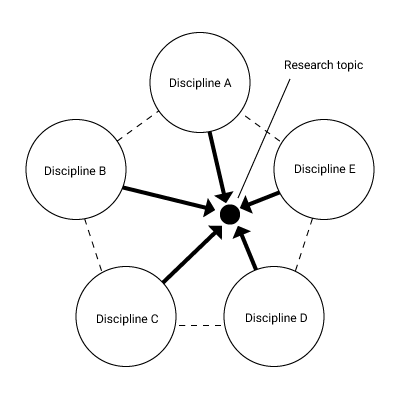Monodisciplinary vs Pluridisciplinary Research
The history, science and politics of pluridisciplinary (often referred to as multidisciplinary or interdisciplinary) research have been the subject of academic debates and inquiry. In addition to these two generic terminologies that have sometimes been used interchangeably, other delineations and refinements of pluridisciplinary research have been suggested. [1]
For the purposes of fine-tuning and sharpening the process of review according to the scope of the studies, it may be of interest to categorize studies into monodisciplinary and pluridisciplinary when appropriate. Research studies increasingly draw on knowledge and expertise outside of one main discipline. In some fields, there are no specific modalities incorporated to deal with pluridisciplinary studies while other instruments may be designed to specifically foster and manage these kinds of research.
Currently in the specialized literature there are ongoing discussions on the different types of pluridisciplinary research. The term pluridisciplinary may be used in the widest sense, i.e., research studies that clearly and genuinely require expertise from a broad range of different disciplinary domains.
The need for academic attention and precision in characterizing and defining various types of pluridisciplinary research has been driven by the fact that pioneering scientific discovery and scholarly achievements have increasingly occurred at the intersections of, or through the involvement of collaborators from, more than one traditional discipline or field of study. Despite these developments, implications of the disciplinary character of research topics on defining optimal peer review processes have not received equal attention within the interested scientific communities.
While recognizing the inherent heterogeneity of the different types of pluridisciplinary research, seven generic principles each with several key insights that are aimed at creating a coherent framework for addressing evaluation. These are:
- variability of goals,
- variability of criteria and indicators,
- leveraging of integration,
- interaction of social and cognitive factors in collaboration,
- management, leadership and coaching,
- iteration in a comprehensive and transparent system,
- effectiveness and impact.
Defining effective and fit-for-purpose approaches of peer review applicable to multi-, inter-, cross- and trans-disciplinary studies is important. Despite some apparent misalignments of scholarly and disciplinary outlooks on pluridisciplinary research (for example, going across the health sciences, to engineering, to arts and humanities), it is hoped that the scheme proposed in this section will create a baseline point of reference including a set of general recommendations for dealing with these variants in a consistent manner. Indeed, if the idea is to promote research collaboration across geographical and disciplinary borders, a common point of reference would be of real value in reconciling or at least in contextualising the different perspectives.
Next section illustrates the interaction of disciplines that give rise to research topics. The boundaries separating some of the four categories from each other may be subject to interpretation when it comes to applying this scheme to real examples.
Definitions and Examples[2]
Multidisciplinarity
Multidisciplinarity is concerned with the study of a research topic within one discipline, with support from other disciplines, bringing together multiple dimensions, but always in the service of the driving discipline. Disciplinary elements retain their original identity. It fosters wider knowledge, information and methods.
Example
Research Topic: Discovery of a particular drug
Host discipline: Pharmacology
Complementing disciplines: Biochemistry, Chemistry, Medicine.
Interdisciplinarity
Interdisciplinarity is concerned with the study of a research topic within multiple disciplines, and with the transfer of methods from one discipline to another. The research topic integrates different disciplinary approaches and methods.
Example
Research Topic: Robotics
Host versus complementing disciplines: this has changed over the years and with the expansion of the field, there could be different host(s) and complementing disciplines from Mechanical, Electrical and Computer engineering, Mathematics, Informatics and Computer Science, Neuroscience or Psychology.
Crossdisciplinarity
Crossdisciplinarity is concerned with the study of a research topic at the intersection of multiple disciplines, and with the commonalities among the disciplines involved.
Example
Research Topic: Biologically Inspired Engineering
Host disciplines: Engineering, Material science
Complementing disciplines: Biology, Zoology Interactions are very strong with commonalities in the way biological systems and engineering counterparts are viewed.
Transdisciplinarity
Transdisciplinarity is concerned at once with what is between, across and beyond all the disciplines with the goal of understanding the present world under an imperative of unity of knowledge.
Example
Research Topic: Synthetic Biology, Cognition, Artificial Intelligence
References
- ↑ For more information please see; European Peer Review Guide Integrating Policies and Practices into Coherent Procedures, 2011, http://www.esf.org
- ↑ Graphics are redrawn by me, please check above reference item for original copies.



